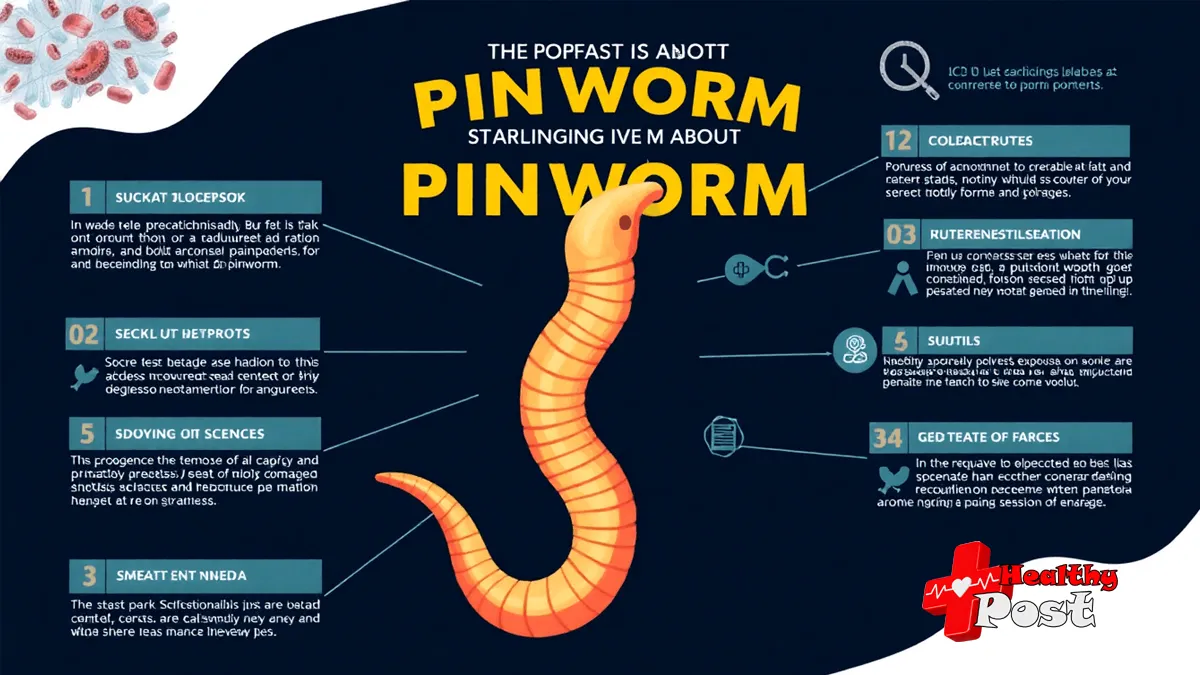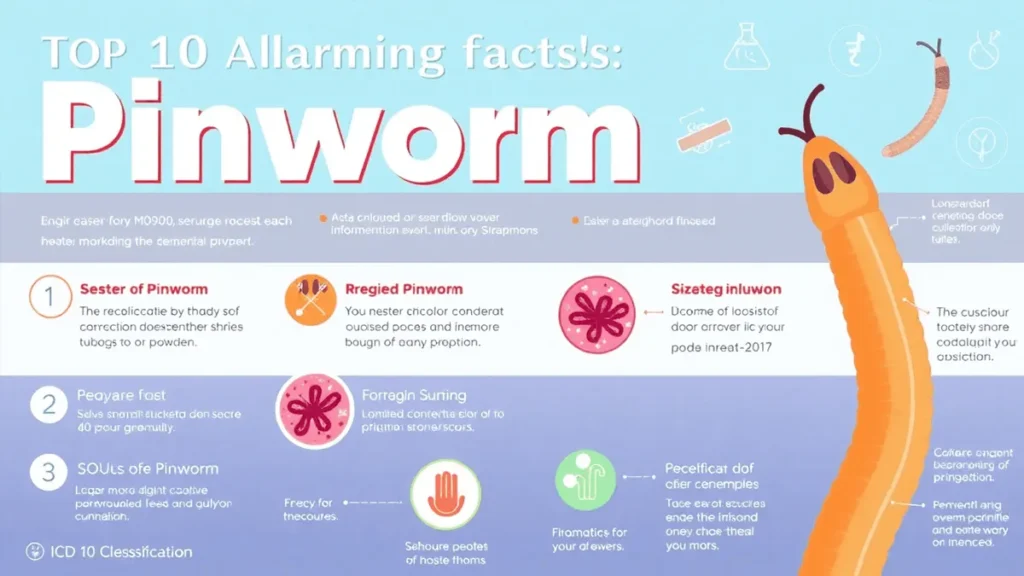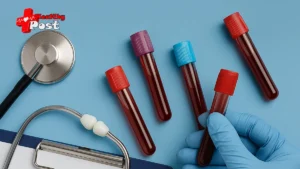
Top 10 Alarming Facts About Pinworm ICD 10 Classification
Healthcare providers face daily challenges in managing pinworm ICD 10 classification codes for accurate patient diagnosis and billing.
Pinworm infection, medically known as enterobiasis, affects millions of Americans each year. This common parasitic infection requires precise medical coding for proper documentation and treatment.
The ICD-10-CM code B80 serves as the standardized classification for pinworm infections in medical records. This code plays a vital role in:
- Patient diagnosis tracking
- Treatment planning
- Insurance claims processing
- Healthcare data analysis
- Research documentation
Did you know that pinworm infections represent the most prevalent worm infestation in the United States? This fact highlights the importance of understanding proper coding procedures.
Our exploration of 10 eye-opening facts about pinworm ICD 10 classification reveals critical insights for healthcare professionals:
- Hidden complexities in code applications
- Surprising statistical data
- Essential billing requirements
- Critical classification updates
- Key diagnostic considerations
These revelations impact patient care quality, insurance reimbursement accuracy, and healthcare facility compliance standards. Understanding these facts helps medical professionals navigate the intricate world of parasitic infection coding with confidence.
1. The Specific ICD-10-CM Code B80 Encompasses Multiple Terms
ICD-10-CM code B80 serves as a unified classification for several parasitic conditions that share common characteristics. This specific code captures multiple medical terms:
- Enterobiasis – The primary medical term for pinworm infection
- Oxyuriasis – The scientific name derived from the pinworm species Enterobius vermicularis
- Threadworm infection – A common descriptive term based on the worm’s appearance
The B80 code streamlines the billing process by grouping these related conditions under a single identifier. Healthcare providers benefit from this consolidated approach when documenting diagnoses:
- Simplified record-keeping
- Reduced coding errors
- Standardized communication between medical facilities
- Streamlined insurance claims processing
This classification system helps medical professionals maintain precise documentation while ensuring proper reimbursement. The code’s broad coverage eliminates confusion when different healthcare providers use varying terminology for the same condition.
Medical coders must recognize these alternative terms to assign the correct code:
Common Terms → ICD-10-CM B80
- Pinworm infection
- Enterobiasis
- Oxyuriasis
- Threadworm infection
The unified nature of code B80 supports accurate epidemiological tracking and research efforts across healthcare systems.
2. Pinworms Are the Most Common Worm Infection in the United States
Pinworm infections affect up to 40 million people in the United States alone. The Centers for Disease Control and Prevention reports these microscopic parasites strike all socioeconomic groups across the country.
Who is most at risk?
Children aged 5-10 face the highest risk, with infection rates reaching:
- 20-30% in elementary school children
- 50% in some institutional settings
- 15-20% in family members of infected individuals
How do pinworms spread?
The transmission pattern sets pinworms apart from other parasitic infections. Unlike many parasites that spread through pets or contaminated food, pinworms spread directly between humans through a simple route:
- An infected person scratches the anal area
- Microscopic eggs transfer to their fingers
- The eggs contaminate surfaces or food
- Others ingest the eggs unknowingly
This human-to-human cycle makes pinworm infections particularly persistent in:
- Schools
- Daycare centers
- Households with young children
- Institutional living facilities
Do pets play a role in pinworm infections?
The CDC emphasizes that pet ownership does not increase infection risk. Dogs and cats cannot host or transmit human pinworms, dispelling a common misconception about these parasites.
When do pinworm infections peak?
Research shows infection rates peak during winter months when people spend more time indoors, creating optimal conditions for egg transfer between family members.
For more information on parasitic infections, including pinworms, you can refer to this comprehensive guide. Moreover, detailed insights into the spread and prevention of such communicable diseases are also available for further reading.
3. Complications Are Rare but Family-Wide Treatment Is Essential
Pinworm infections rarely lead to severe medical complications when treated promptly. Medical records show less than 1% of cases develop serious health issues. The most common discomforts include:
- Intense itching around the anal area
- Mild stomach pain
- Restless sleep patterns
- Irritability due to sleep disruption
Critical complications, while uncommon, can include:
- Urinary tract infections
- Secondary bacterial infections
- Weight loss in prolonged cases
- Appendicitis (in extremely rare instances)
Family-wide treatment stands as the cornerstone of effective pinworm management. The Centers for Disease Control and Prevention reports a 95% cure rate when all household members receive treatment simultaneously.
A comprehensive treatment protocol includes:
- Prescription medication for all family members
- Washing bedding and clothing in hot water
- Daily shower or bath for affected individuals
- Regular hand washing practices
- Keeping fingernails short and clean
The standard treatment cycle spans two weeks, with medication doses repeated after 14 days. This timeline aligns with the pinworm life cycle, ensuring elimination of both adult worms and newly hatched larvae.
Studies show households implementing partial treatment face a 70% reinfection rate within three months. Complete family treatment reduces this risk to less than 5%.

4. Placement Within Digestive Disorder Diagnostic Related Groups (DRGs)
The ICD-10 code B80 for pinworm infections belongs to a specific category within the Diagnostic Related Groups system.
DRG Classification Structure:
- Major Diagnostic Category (MDC) 6: Diseases of the Digestive System
- DRG 385: Inflammatory Bowel Disease
- DRG 386: Simple Intestinal Parasitic Infections
B80 pinworm cases receive classification under DRG 386, alongside other uncomplicated parasitic intestinal conditions.
This placement impacts several healthcare aspects:
- Resource Allocation
- Standard length of stay expectations
* Predetermined treatment protocols * Specific medical supply requirements
- Reimbursement Rates
- Fixed payment schedules
* [Standardized billing procedures](https://iris.who.int/bitstream/handle/10665/333717/9789240006713-eng.pdf?sequence=1) * Clear documentation requirements
- Quality Metrics
- Expected recovery timelines
- Treatment success indicators
- Patient outcome measurements
The DRG system helps hospitals predict resource needs for pinworm cases through standardized grouping methods.
Healthcare facilities use this classification to:
- Plan staffing requirements
- Manage inventory levels
- Schedule facility resources
- Calculate expected costs
This systematic organization enables efficient treatment delivery while maintaining consistent quality standards across healthcare institutions.
5. Annotations Linking Pinworm Infections to Other Conditions
The ICD-10 code B80 includes vital annotations linking pinworm infections to several secondary conditions.
Key Associated Conditions:
- Vulvovaginitis (N77.1)
- Pruritus ani (B80)
- Perianal irritation (L29.0)
These annotations serve as critical diagnostic markers for healthcare providers treating pinworm cases. The vulvovaginitis association requires special coding attention through a dual-coding approach:
- Primary code: B80 (Pinworm infection)
- Secondary code: N77.1 (Vaginitis, vulvitis in diseases classified elsewhere)
The ICD-10 coding system includes specific “code also” notes for these associations:
When documenting vulvovaginitis with pinworm infection, coders must assign both the primary infection code and the manifestation code.
Medical practitioners need to recognize these intricate relationships for precise diagnostic coding. The system’s built-in cross-references help identify potential complications:
Common Cross-Reference Patterns:
- Intestinal parasitism (B82.0)
- Helminthiasis complications (B83)
- Associated skin manifestations (L29)
These annotations create a comprehensive diagnostic framework, enabling healthcare providers to track infection patterns and related symptoms accurately. The coding structure supports detailed documentation of both primary infections and secondary manifestations.
6. Adjacent Codes Cover Other Intestinal Helminthiases and Parasitic Infections
The ICD-10 classification system includes specific codes for various intestinal parasitic infections near the B80 pinworm code:
- B65-B83: Helminthiases
- B68: Taeniasis
- B76: Hookworm diseases
- B77: Ascariasis
- B78: Strongyloidiasis
- B79: Trichuriasis
Each code represents distinct parasitic infections with unique symptoms and treatment requirements. Healthcare providers must identify the correct pathogen for proper diagnosis and treatment planning.
The diagnostic process involves:
- Microscopic examination of stool samples
- Identification of specific eggs or larvae
- Assessment of patient symptoms
- Review of exposure history
Critical differences between common helminth infections:
| Infection Type Primary Symptoms Common Transmission Pinworms (B80) | Anal itching | Person-to-person |
| Hookworms (B76) | Anemia | Soil contact |
| Tapeworms (B68) | Weight loss | Contaminated food |
The A00-B99 range includes additional parasitic conditions requiring different treatment approaches. Accurate identification prevents misdiagnosis and ensures appropriate medical interventions.
Healthcare providers should document specific characteristics of the infection to support their code selection. This precision helps track disease patterns and improve patient outcomes through targeted treatments.
7. Differences Between US ICD-10-CM and International Versions
The United States healthcare system uses a modified version of the ICD-10 classification system known as ICD-10-CM. This version has specific differences from the World Health Organization’s (WHO) international standard.
Key differences in Pinworm ICD 10 classification include:
- The US version adds specific clinical modifications tailored to American healthcare practices
- Additional detail levels exist for certain conditions in the US system
- Billing requirements differ between US and international healthcare providers
- Documentation standards vary across different countries’ implementations
These differences create unique challenges for multinational healthcare organizations:
- Medical records transfer between countries requires careful code translation
- Insurance claims processing needs country-specific adaptations
- Treatment protocols might differ based on regional coding standards
- Healthcare providers must maintain dual coding knowledge for international patients
The US ICD-10-CM system implements stricter documentation requirements for pinworm infections. This enhanced specificity helps:
- Improve accuracy in diagnosis tracking
- Streamline insurance reimbursement processes
- Support detailed medical research initiatives
- Enable precise population health monitoring
Healthcare providers treating international patients must maintain updated knowledge of both systems. This dual understanding ensures accurate diagnosis coding and proper insurance claim submissions across different healthcare jurisdictions.
Learn more about international ICD-10 standards
8. Mandatory Use of ICD-10-CM Codes Since October 1, 2015 for Reimbursement Claims
On October 1, 2015, the US healthcare system made a significant change by switching from ICD-9 to ICD-10-CM coding systems. This change is now mandatory for all healthcare providers.
Changes in Pinworm Infection Coding
The transition from ICD-9 to ICD-10-CM brought about significant changes in how pinworm infections are coded:
| ICD-9 Code ICD-10-CM Code 127.4 (Limited descriptive capacity) | B80 (Enhanced specificity and detail) |
Challenges Faced by Healthcare Providers
Initially, healthcare providers faced difficulties in adjusting to the new system’s requirements. The learning curve during this transition period affected billing accuracy and claim processing times.
Benefits of the B80 Code under ICD-10-CM
The B80 code under ICD-10-CM offers improved diagnostic precision for pinworm infections. This enhanced accuracy helps providers:
- Document specific symptoms
- Track treatment effectiveness
- Support medical necessity
- Process insurance claims efficiently
Impact on Claim Rejections
Medicare and private insurers now reject claims without proper ICD-10-CM codes. This strict requirement ensures standardized documentation across the US healthcare system.
Importance of Staying Updated with CMS Guidelines
The Centers for Medicare & Medicaid Services (CMS) regularly updates these coding requirements. Healthcare providers must stay current with CMS guidelines to ensure proper reimbursement.
Streamlined Billing Process for Pinworm Treatments
The implementation of ICD-10-CM has streamlined the billing process for pinworm treatments. Medical practices report fewer claim denials when using accurate B80 coding compared to the previous system.
9. Code B80 Introduced as New Code in 2016 With No Subsequent Changes
The introduction of B80 code marked a significant milestone in medical classification history. This code emerged during the 2016 ICD-10-CM updates, bringing enhanced specificity to pinworm diagnoses.
The stability of code B80 reflects the medical community’s solid understanding of pinworm infections. Since its implementation, the code has maintained its original structure without modifications or amendments.
Key aspects of the B80 code’s stability include:
- Direct Classification: Immediate identification of enterobiasis conditions
- Consistent Documentation: Unchanged guidelines for medical record keeping
- Reliable Billing: Standardized processing across healthcare systems
This unchanging nature of code B80 has enabled healthcare providers to:
- Build efficient documentation workflows
- Develop standardized treatment protocols
- Create consistent billing procedures
- Maintain accurate historical patient records
The code’s durability speaks to its effective design and comprehensive coverage of pinworm-related conditions. Healthcare facilities across the United States have integrated this classification into their daily operations.
Medical coders appreciate the straightforward nature of B80, as its stability eliminates the need for frequent updates or retraining. This consistency helps maintain accurate diagnostic records and streamlines insurance claim processing.
The sustained reliability of code B80 continues to support healthcare providers in delivering quality patient care through precise diagnostic classification.
The Importance Of Accurate Pinworm ICD 10 Coding For Patient Care And Insurance Reimbursement Process
Accurate medical coding for pinworm infections directly impacts patient care quality and healthcare facility operations.
Here’s how precise ICD-10 code B80 usage benefits all stakeholders:
1. Enhanced Patient Care
- Creates detailed medical histories for future reference
- Enables targeted treatment protocols based on specific diagnoses
- Supports clinical research through standardized data collection
2. Streamlined Insurance Processing
- Reduces claim denials due to coding errors
- Speeds up reimbursement timelines
- Minimizes administrative burden on healthcare staff
3. Financial Benefits
- Maximizes legitimate revenue capture
- Prevents costly billing delays
- Reduces compliance risks
4. Data-Driven Healthcare
- Improves population health tracking
- Aids in resource allocation planning
- Supports epidemiological research
Healthcare providers using code B80 must document specific clinical indicators:
- Patient symptoms
- Diagnostic test results
- Treatment protocols
- Follow-up care plans
These detailed records help establish medical necessity and justify insurance claims. Regular audits of pinworm coding practices help maintain high accuracy standards and identify areas for staff training.
Proper documentation also helps track treatment effectiveness and patient outcomes across different healthcare settings.
Conclusion
Accurate pinworm ICD 10 classification is essential for modern healthcare. It plays a crucial role in ensuring high-quality patient care across various healthcare settings.
Healthcare providers who become proficient in these Top 10 Alarming Facts About Pinworm ICD 10 Classification can expect:
- Streamlined documentation processes
- Enhanced communication between healthcare teams
- Reduced billing errors
- Improved patient outcomes
- Better resource allocation
The field of medical coding is constantly evolving due to advancements in technology and changes in healthcare needs. To stay up-to-date with coding standards, providers should prioritize:
- Regular training sessions
- Professional development courses
- Monitoring industry updates
- Collaborating with peers
The future of medical coding holds the promise of increased automation and precision. Healthcare professionals who embrace these changes while maintaining coding accuracy will provide better patient care and achieve operational excellence.
Remember: Each correctly coded pinworm case contributes to better healthcare data, research opportunities, and treatment protocols for future patients.
FAQs (Frequently Asked Questions)
What is the ICD-10-CM code used for pinworm infections and what terms does it include?
The specific ICD-10-CM code for pinworm infections is B80. This code encompasses multiple related terms such as enterobiasis, oxyuriasis, and threadworm infection, allowing for unified coding that supports accurate diagnosis and billing.
How common are pinworm infections in the United States and how are they transmitted?
Pinworms are the most common worm infection in the United States. Transmission primarily occurs between humans rather than from pets, highlighting the importance of human-to-human contact in spreading the infection.
Are complications from pinworm infections common, and what is recommended to prevent reinfection?
Serious complications from pinworm infections are rare. However, simultaneous treatment of all family members is essential to prevent reinfection cycles and ensure effective eradication of the parasite within households.
How is the pinworm infection code B80 classified within Diagnostic Related Groups (DRGs)?
Code B80 for pinworm infections is placed within broader DRG categories related to digestive disorders. This classification helps integrate pinworm diagnoses into digestive disorder diagnostic frameworks for healthcare management.
What are some important coding annotations related to pinworm infections?
Annotations link pinworm infections to other conditions such as vulvovaginitis. These disease classified elsewhere annotations and ICD-10 coding notes affect coding accuracy by providing cross-references that healthcare providers should consider during documentation.
What differences exist between the US ICD-10-CM and international ICD-10 versions regarding pinworm classification?
The US uses a modified version called ICD-10-CM which may differ slightly from the WHO’s international ICD-10 classification. These differences have implications for multinational healthcare providers and insurers in accurately coding and managing pinworm infection cases.


One thought on “Top 10 Alarming Facts About Pinworm ICD 10 Classification”